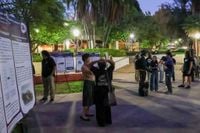Arizona is bracing for a dramatic shift in its fiscal landscape as state agencies reveal the staggering costs of adapting to sweeping federal spending and tax changes ushered in by President Donald Trump’s “One Big Beautiful Bill,” formally known as H.R. 1. With key provisions of the legislation set to take effect in 2027 and 2028, state officials warn that the price tag for compliance could reach hundreds of millions of dollars, straining the state’s budget and threatening vital public services.
According to budget requests submitted by Arizona’s state agencies on September 20, 2025, the Arizona Health Care Cost Containment System (AHCCCS) projects it will need $71.4 million in fiscal year 2027 alone to implement the Medicaid changes mandated by H.R. 1. Of that sum, $18.78 million would come directly from the state’s general fund, pending inclusion in the 2026 budget. The agency’s budget request spells out the challenge in stark terms: “H.R. 1 will represent a significant expansion in the cost burden on the state of Arizona and in particular, the state general fund.”
But the impact doesn’t stop with Medicaid. The Department of Economic Security (DES), which oversees both Medicaid and the Supplemental Nutrition Assistance Program (SNAP), is seeking $87.7 million from the general fund in fiscal year 2027 to handle eligibility adjustments for both programs. That’s on top of a request for $18.2 million in supplemental funding for the current fiscal year, which began July 1, 2025. The extra funds, according to DES, are needed to manage heavier workloads triggered by SNAP work requirement changes and new H.R. 1 provisions that shift payment error costs from the federal government to the states.
“SNAP and Medicaid program operations will be disrupted and potentially not be possible at all if these costs are not funded with state dollars,” DES warned in its budget submission. The agency estimates it will need 228 full-time equivalent staff positions in 2027 to keep pace with the new demands, while AHCCCS projects a need for 92 additional staffers that same year. Looking ahead to fiscal year 2028, AHCCCS is bracing for another $5.3 million in costs related to the federal changes, with $1.6 million expected to come from the state’s general fund.
The ripple effects of the federal overhaul are being felt across Arizona’s government. The Department of Health Services (ADHS) is requesting $2 million from the general fund to fill the gap left by the loss of federal funds that have supported the Arizona State Public Health Laboratory. The lab, which investigates infectious disease outbreaks, conducts newborn screenings, and tests drinking and surface water for communicable diseases, serves cities, counties, school districts, and more. State law prohibits ADHS from charging for these services, making state support critical. The agency’s budget request frames the issue plainly: state funding is needed to ensure uninterrupted services in a “very unstable federal funding climate.”
Foster care is another area under pressure. The Department of Child Services (DCS) is seeking $24.6 million in general fund money, in part to address changes to eligibility for Title IV-E, the federal program that helps cover foster care maintenance costs. Without this infusion, DCS warns, Arizona could struggle to support its most vulnerable children.
Environmental protection is also on the line. The Department of Environmental Quality (ADEQ) says it will not be able to meet federal Clean Air Act requirements unless it receives $3.9 million from the general fund in fiscal year 2027. Grants supporting Clean Air Act compliance were among those cut by H.R. 1, creating a funding shortfall that puts Arizona’s air quality goals at risk.
Border security, a perennial concern in Arizona, is likewise affected. The Department of Homeland Security (ADOHS) is requesting nearly $800,000 annually from the general fund to keep the Border Coordination Office running after its current funding source—the American Rescue Plan Act—expires in September 2026. The office was created by Governor Katie Hobbs in 2023 to coordinate border operations, and the agency’s budget request underscores the need for ongoing state support as federal dollars dry up.
Governor Hobbs and her administration have not minced words about the challenges ahead. While her office declined to comment directly on the latest agency budget requests, spokesperson Christian Slater previously told the Arizona Capitol Times that the upcoming budget would be tough to balance “due to the reckless actions of the Trump administration.” In a statement from August, Slater said, “H.R. 1 slashes funding for critical services Arizonans rely on while overloading the state with bureaucracy and red tape that will cost significant taxpayer dollars.”
According to the AHCCCS budget request, the state will face “significant increases in administrative expenses and will be asked to make tough policy decisions as providers’ revenues decrease while uncompensated care increases.” For agencies like DES, the stakes are equally high, with the risk that “program operations will be disrupted and potentially not be possible at all if these costs are not funded with state dollars.”
All told, the requests from AHCCCS, DES, ADHS, DCS, ADEQ, and ADOHS paint a picture of a state government scrambling to backfill federal cuts and keep essential services afloat. The cumulative effect is a looming fiscal crunch that will force lawmakers to make difficult choices about spending, priorities, and the future of public programs in Arizona.
Governor Hobbs’ office will use the agency requests to craft her executive budget proposal, which is slated for release in January 2026 and will serve as the starting point for what is sure to be a contentious round of budget negotiations with the Legislature. Every dollar requested by the agencies must ultimately be approved by both the Legislature and the governor herself, setting the stage for a high-stakes debate over how Arizona will weather the changes imposed by H.R. 1.
In the coming months, as lawmakers, agency heads, and advocacy groups pore over the numbers and weigh the consequences, the reality is clear: the financial burden of federal policy changes is about to hit Arizona’s bottom line in a big way. Whether the state can absorb those costs without sacrificing key services—or whether Arizonans will feel the pinch in their daily lives—remains an open question, but the clock is ticking as 2027 approaches.




